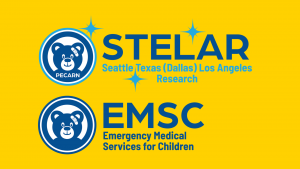Authors: Kyle Smiley (EM Resident, BAMC, San Antonio, TX) // Reviewed by: Alex Koyfman, MD (@EMHighAK); Brit Long, MD (@long_brit)
Welcome to Critical Kids, an emDOCs series focused on pediatric emergency medicine. Pediatric emergencies are challenging. We’ll provide summaries of the evidence to support your decisions at the bedside. Today we cover the Phoenix Sepsis Criteria.
Background
- Each year, pediatric sepsis results in more than 3 million deaths globally1
- In children less than 5 years old, preterm birth and bacterial sepsis account for 50% of all deaths2
- 20-35% of children admitted for sepsis are at high-risk for long-term health complications3,4
- Physicians are notoriously poor at determining which pediatric patients have sepsis5
- Prior pediatric sepsis mortality prediction scores such as SIRS and pediatric SOFA (pSOFA) have poor predictive characteristics6
- Sensitivities range from 74.1-97.6% but PPV ranges from 25.1-39.5%
- Neonatal sepsis scores perform well but are not generalizable to older children7,8
- Correctly identifying pediatric patients that require rapid antimicrobial treatment is essential9
Study Design
- Development and Validation of the Phoenix Criteria for Pediatric Sepsis and Septic Shock is a multicenter, international retrospective cohort study intended to develop new clinical criteria for pediatric sepsis and septic shock10
- Included patients <18 years old with suspected infection within 24 hours of admission to the emergency department, inpatient, or ICU setting between 2010 and 2019
- Newborn birth hospitalizations and children with postconceptional age <37 weeks were excluded
- Analyzed each subgroup from 8 previously validated measures of pediatric organ dysfunction against patients with and without suspected infection in derivation cohort
- Included IPSCC, PELOD-2, PODIUM, Proulx, pSOFA, DIC, VIS, SI scores
- Combined the best performing subgroups into a composite scoring system used to train stacked regression models
- Quantified performance by area under precision recall curve (AUPRC)
- More accurate than area under the receiver operating characteristic curve (AUROC) when comparing vastly disparate groups (e.g., overwhelming majority of subject survive)
- Used modified Delphi process when regression models or component performance was similar
- Final stacked regression model was converted to an integer score
- Quantified performance by area under precision recall curve (AUPRC)
- Task force utilized modified Delphi process to vote on thresholds for sepsis and septic shock to optimize sensitivity and positive predictive value (PPV)
- Performed internal and external validity analyses on derivation hospital and external validation hospital data sets, respectively
- Primary outcome was in-hospital mortality
- Secondary outcome was death within 72 hours of presentation or requirement of ECMO
- Included to avoid confounders of death from iatrogenic complications or children who otherwise would have died at non-ECMO centers
- Secondary outcome was death within 72 hours of presentation or requirement of ECMO
- Included patients <18 years old with suspected infection within 24 hours of admission to the emergency department, inpatient, or ICU setting between 2010 and 2019
Study Results
- Screened 3,751,591 hospital encounters for patients with signs of infection in first 24 hours
- 759,774 encounters used to determine best criteria for organ dysfunction for each organ system
- Derivation cohort: 129,584 patients with mean age 3.7 years
- Internal validation cohort: 43,400 patients with mean age 3.7 years
- External validation cohort: 45,855 patients with mean age 2.6 years
- Best performing criteria identified by AUPRC and AUROC
- 4-organ-system model translated into the Phoenix Sepsis Score had best mortality prediction characteristics
- AUPRC of 0.23-0.38 (95% CI 0.20-0.39)
- AUROC of 0.71-0.92 (95% CI 0.70-0.92)
- 4-organ-system model translated into the Phoenix Sepsis Score had best mortality prediction characteristics
- Included Respiratory, Cardiovascular, Coagulation, Neurologic components
- Integer score calculated for each component and combined
- Range of 0-13, with higher value indicating more severe infection(Table 1)
- Median score in sepsis patients was 3 (IQR 2-4)
- Score of 2+ points had best performance characteristics for primary outcome of death at higher resource sites with sensitivity of 69.2-84.4% and PPV of 5.3-7.1% for derivation and external validation sets; at lower resource sites, sensitivity was 81.2% and PPV of 22.2% in derivation and validation sets
- When increasing to >2 points, increase PPV but reduce sensitivity
- Sensitivity is more important as a screening tool but must balance with not triggering every single patient who enters the ED as sepsis
- Range of 0-13, with higher value indicating more severe infection(Table 1)
- Integer score calculated for each component and combined

Strengths
- Large sample size with robust statistical analysis
- Included domestic and international hospitals with diverse resource availability to increase external generalizability
- Also useful in low-resource settings
- Superior performance compared to prior pediatric sepsis scores
Weaknesses/Limitations
- Retrospective cohort studies are susceptible to selection and recall bias
- Attempted to overcome this by including low-and-high-resource settings in domestic and international hospitals
- Complicated scoring system compared to other sepsis scores
- Some laboratory values may not be available at your facility
- Requires PaO2:FiO2 or SpO2:FiO2
- Not cost-effective to obtain these labs on every suspected patient
- Some laboratory values may not be available at your facility
Next Steps
- Validation study needed before broad adaption can be recommended
Summary
- Robust data analysis applicable to broad range of hospitals with varied resources
- Combined score of 2+ is positive for sepsis
- May not be able to obtain all laboratory values in your institution
- Not fully validated, significantly limiting use
References:
- Rudd KE, Johnson SC, Agesa KM, et al. Global, regional, and national sepsis incidence and mortality, 1990-2017: analysis for the Global Burden of Disease Study. Lancet. 2020 Jan 18;395(10219):200-211. doi: 10.1016/S0140-6736(19)32989-7. PMID: 31954465; PMCID: PMC6970225.
- Strunk T, Molloy EJ, Mishra A, Bhutta ZA. Neonatal bacterial sepsis. Lancet. 2024 Jun 26:S0140-6736(24)00495-1. doi: 10.1016/S0140-6736(24)00495-1. Epub ahead of print. PMID: 38944044.
- Carlton EF, Gebremariam A, Maddux AB, et al. New and Progressive Medical Conditions After Pediatric Sepsis Hospitalization Requiring Critical Care. JAMA Pediatr. 2022 Nov 1;176(11):e223554. doi: 10.1001/jamapediatrics.2022.3554. Epub 2022 Nov 7. PMID: 36215045; PMCID: PMC9552050.
- Zimmerman JJ, Banks R, Berg RA, et al; Life After Pediatric Sepsis Evaluation (LAPSE) Investigators. Trajectory of Mortality and Health-Related Quality of Life Morbidity Following Community-Acquired Pediatric Septic Shock. Crit Care Med. 2020 Mar;48(3):329-337. doi: 10.1097/CCM.0000000000004123. PMID: 32058370; PMCID: PMC7164680.
- Weiss SL, Fitzgerald JC, Maffei FA, et al; SPROUT Study Investigators and Pediatric Acute Lung Injury and Sepsis Investigators Network. Discordant identification of pediatric severe sepsis by research and clinical definitions in the SPROUT international point prevalence study. Crit Care. 2015 Sep 16;19(1):325. doi: 10.1186/s13054-015-1055-x. PMID: 26373923; PMCID: PMC4572676.
- Zhao C, Xin MY, Li J, et al. Comparing the precision of the pSOFA and SIRS scores in predicting sepsis-related deaths among hospitalized children: a multi-center retrospective cohort study. World J Emerg Med. 2022;13(4):259-265. doi: 10.5847/wjem.j.1920-8642.2022.060. PMID: 35837567; PMCID: PMC9233967.
- Kuppermann N, Dayan PS, Levine DA, et al; Febrile Infant Working Group of the Pediatric Emergency Care Applied Research Network (PECARN). A Clinical Prediction Rule to Identify Febrile Infants 60 Days and Younger at Low Risk for Serious Bacterial Infections. JAMA Pediatr. 2019 Apr 1;173(4):342-351. doi: 10.1001/jamapediatrics.2018.5501. PMID: 30776077; PMCID: PMC6450281.
- Mintegi S, Bressan S, Gomez B, et al. Accuracy of a sequential approach to identify young febrile infants at low risk for invasive bacterial infection. Emerg Med J. 2014 Oct;31(e1):e19-24. doi: 10.1136/emermed-2013-202449. Epub 2013 Jul 14. PMID: 23851127.
- Sivasankar S, Goldman JL, Hoffman MA. Variation in antibiotic resistance patterns for children and adults treated at 166 non-affiliated US facilities using EHR data. JAC Antimicrob Resist. 2023 Jan 2;5(1):dlac128. doi: 10.1093/jacamr/dlac128. PMID: 36601546; PMCID: PMC9806600.
- Sanchez-Pinto LN, Bennett TD, DeWitt PE, et al. Development and Validation of the Phoenix Criteria for Pediatric Sepsis and Septic Shock. JAMA. 2024 Feb 27;331(8):675-686. doi: 10.1001/jama.2024.0196. PMID: 38245897; PMCID: PMC10900964.








